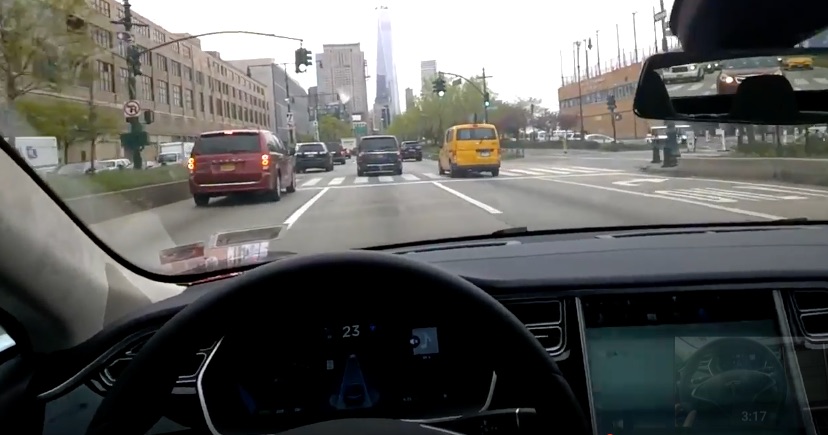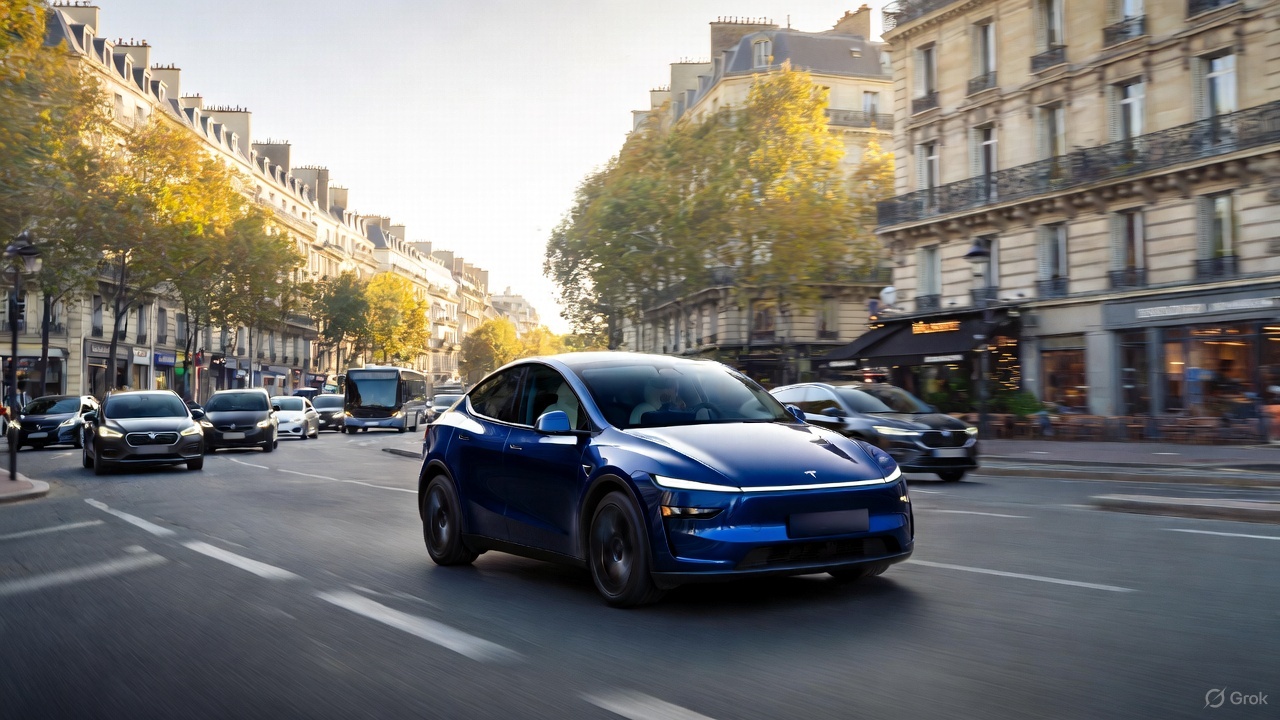News
Your Tesla will become a humanless chauffeur, summoned via app

Your Tesla eases its way through the choked streets of Los Angeles and climbs the Sierra Nevada. It glitters with the lights of Las Vegas before continuing over to Yellowstone National Park, where the geysers blow and the buffalo stare from roadsides. Meandering through the Badlands and by Mount Rushmore, it pushes upward in elevation into the Rockies and then down to Denver. After the Tesla powers past the Midwest’s cornfields, it propels its way through Chicago’s multiple highway lanes, wedged between tractor trailers. In the final leg of the trip, the Tesla dips and zips through Pennsylvania’s rolling hills and maneuvers through the congested streets of Times Square, parking itself.
These Northern route stats: 3,241 miles in 54 hours, and your Tesla did all the driving for you. It was capable of seeing through heavy rain, fog, dust, and two cars ahead.
That’s the vision, or Tesla Vision, rather, of the not-so-distant future as announced by Tesla CEO Elon Musk during a press conference call on Wednesday, October 19. Outlining a future of self-driving cars, Musk set a goal for Tesla to make a fully autonomous road trip from Los Angeles to New York by the end of 2017. The trip would occur “without the need for a single touch” from the driver, including recharging the car’s battery. Owners would be able to Summon their vehicle, through a press of a button on an app, and the car would drive itself to wherever they are and pick them up – even if it’s across the country. The vehicle would charge on its own along the way without human intervention using something similar to the Snakebot that Tesla revealed last year.
“Our goal— I feel pretty good about this goal — we’ll be able to do a demonstration drive of full autonomy all the way from LA to New York. So basically from a home in LA to, let’s say. dropping you off in Times Square, in New York, having the car park itself by next year. Without the need for a single touch, including the charger.”, says Musk.
When you want your car to return, tap Summon on your phone. It will eventually find you even if you are on the other side of the country
— Elon Musk (@elonmusk) October 20, 2016
This Level 5 “full self-driving or driverless capacity” will now be available on the 2,000 cars a week that Tesla is currently manufacturing. That means the Tesla Model S and Model X vehicles in production as well as the upcoming Model 3 will have what Musk terms “Hardware 2,” which allows for full self-driving capability at “a safety level substantially greater than that of a human driver,” according to Musk. The hardware includes:
- 8 surround cameras which provide 360 degree visibility around the car at up to 250 meters of range;
- 12 updated ultrasonic sensors that allow detection of both hard and soft objects at nearly twice the distance of the prior system; and,
- a forward-facing radar with enhanced processing that provides additional data on a redundant wavelength.
The system, which has been more than a year in testing, will see continual software updates as the system learns through data collected from ‘Shadow Mode’ and self-driving algorithms are refined. Musk said that it would be some time before Tesla’s software would advance to meet capabilities of Hardware 2, so it will be disabled until it “reaches parity following full validation with Hardware 1, probably in December.” Updates are likely to occur every 2-3 months thereafter. Nonetheless, and in lieu of required regulatory approval, Musk claims that the safety level of this autonomous driving will be at least twice that of a human, or better.
Tesla’s current Autopilot system has been replaced with a newer generation ‘Enhanced Autopilot’ that will leverage the new suite of sensors to provide more precise lane keeping, lane changes without driver input, the ability to exit freeways, and an overall smoother and safer experience. Enhanced Autopilot and the Fully Self-Driving Capability, autonomous mode, is being made available through Tesla’s Model S and Model X Design Studio as optional upgrades.

News
Man credits Grok AI with saving his life after ER missed near-ruptured appendix
The AI flagged some of the man’s symptoms and urged him to return to the ER immediately and demand a CT scan.

A 49-year-old man has stated that xAI’s Grok ended up saving his life when the large language model identified a near-ruptured appendix that his first ER visit dismissed as acid reflux.
After being sent home from the ER, the man asked Grok to analyze his symptoms. The AI flagged some of the man’s symptoms and urged him to return immediately and demand a CT scan. The scan confirmed that something far worse than acid reflux was indeed going on.
Grok spotted what a doctor missed
In a post on Reddit, u/Tykjen noted that for 24 hours straight, he had a constant “razor-blade-level” abdominal pain that forced him into a fetal position. He had no fever or visible signs. He went to the ER, where a doctor pressed his soft belly, prescribed acid blockers, and sent him home.
The acid blockers didn’t work, and the man’s pain remained intense. He then decided to open a year-long chat he had with Grok and listed every detail that he was experiencing. The AI responded quickly. “Grok immediately flagged perforated ulcer or atypical appendicitis, told me the exact red-flag pattern I was describing, and basically said “go back right now and ask for a CT,” the man wrote in his post.
He copied Grok’s reasoning, returned to the ER, and insisted on the scan. The CT scan ultimately showed an inflamed appendix on the verge of rupture. Six hours later, the appendix was out. The man said the pain has completely vanished, and he woke up laughing under anesthesia. He was discharged the next day.
How a late-night conversation with Grok got me to demand the CT scan that saved my life from a ruptured appendix (December 2025)
byu/Tykjen ingrok
AI doctors could very well be welcomed
In the replies to his Reddit post, u/Tykjen further explained that he specifically avoided telling doctors that Grok, an AI, suggested he get a CT scan. “I did not tell them on the second visit that Grok recommended the CT scan. I had to lie. I told them my sister who’s a nurse told me to ask for the scan,” the man wrote.
One commenter noted that the use of AI in medicine will likely be welcomed, stating that “If AI could take doctors’ jobs one day, I will be happy. Doctors just don’t care anymore. It’s all a paycheck.” The Redditor replied with, “Sadly yes. That is what it felt like after the first visit. And the following night could have been my last.”
Elon Musk has been very optimistic about the potential of robots like Tesla Optimus in the medical field. Provided that they are able to achieve human-level articulation in their hands, and Tesla is able to bring down their cost through mass manufacturing, the era of AI-powered medical care could very well be closer than expected.
News
Tesla expands Model 3 lineup in Europe with most affordable variant yet
The Model 3 Standard still delivers more than 300 miles of range, potentially making it an attractive option for budget-conscious buyers.

Tesla has introduced a lower-priced Model 3 variant in Europe, expanding the lineup just two months after the vehicle’s U.S. debut. The Model 3 Standard still delivers more than 300 miles (480 km) of range, potentially making it an attractive option for budget-conscious buyers.
Tesla’s pricing strategy
The Model 3 Standard arrives as Tesla contends with declining registrations in several countries across Europe, where sales have not fully offset shifting consumer preferences. Many buyers have turned to options such as Volkswagen’s ID.3 and BYD’s Atto 3, both of which have benefited from aggressive pricing.
By removing select premium finishes and features, Tesla positioned the new Model 3 Standard as an “ultra-low cost of ownership” option of its all-electric sedan. Pricing comes in at €37,970 in Germany, NOK 330,056 in Norway, and SEK 449,990 in Sweden, depending on market. This places the Model 3 Standard well below the “premium” Model 3 trim, which starts at €45,970 in Germany.
Deliveries for the Standard model are expected to begin in the first quarter of 2026, giving Tesla an entry-level foothold in a segment that’s increasingly defined by sub-€40,000 offerings.
Tesla’s affordable vehicle push
The low-cost Model 3 follows October’s launch of a similarly positioned Model Y variant, signaling a broader shift in Tesla’s product strategy. While CEO Elon Musk has moved the company toward AI-driven initiatives such as robotaxis and humanoid robots, lower-priced vehicles remain necessary to support the company’s revenue in the near term.
Reports have indicated that Tesla previously abandoned plans for an all-new $25,000 EV, with the company opting to create cheaper versions of existing platforms instead. Analysts have flagged possible cannibalization of higher-margin models, but the move aims to counter an influx of aggressively priced entrants from China and Europe, many of which sell below $30,000. With the new Model 3 Standard, Tesla is reinforcing its volume strategy in Europe’s increasingly competitive EV landscape.
News
Tesla FSD (Supervised) stuns Germany’s biggest car magazine
FSD Supervised recognized construction zones, braked early for pedestrians, and yielded politely on narrow streets.

Tesla’s upcoming FSD Supervised system, set for a European debut pending regulatory approval, is showing notably refined behavior in real-world testing, including construction zones, pedestrian detection, and lane changes, as per a recent demonstration ride in Berlin.
While the system still required driver oversight, its smooth braking, steering, and decision-making illustrated how far Tesla’s driver-assistance technology has advanced ahead of a potential 2026 rollout.
FSD’s maturity in dense city driving
During the Berlin test ride with Auto Bild, Germany’s largest automotive publication, a Tesla Model 3 running FSD handled complex traffic with minimal intervention, autonomously managing braking, acceleration, steering, and overtaking up to 140 km/h. It recognized construction zones, braked early for pedestrians, and yielded politely on narrow streets.
Only one manual override was required when the system misread a converted one-way route, an example, Tesla stated, of the continuous learning baked into its vision-based architecture.
Robin Hornig of Auto Bild summed up his experience with FSD Supervised with a glowing review of the system. As per the reporter, FSD Supervised already exceeds humans with its all-around vision. “Tesla FSD Supervised sees more than I do. It doesn’t get distracted and never gets tired. I like to think I’m a good driver, but I can’t match this system’s all-around vision. It’s at its best when both work together: my experience and the Tesla’s constant attention,” the journalist wrote.
Tesla FSD in Europe
FSD Supervised is still a driver-assistance system rather than autonomous driving. Still, Auto Bild noted that Tesla’s 360-degree camera suite, constant monitoring, and high computing power mark a sizable leap from earlier iterations. Already active in the U.S., China, and several other regions, the system is currently navigating Europe’s approval pipeline. Tesla has applied for an exemption in the Netherlands, aiming to launch the feature through a free software update as early as February 2026.
What Tesla demonstrated in Berlin mirrors capabilities already common in China and the U.S., where rival automakers have rolled out hands-free or city-navigation systems. Europe, however, remains behind due to a stricter certification environment, though Tesla is currently hard at work pushing for FSD Supervised’s approval in several countries in the region.








